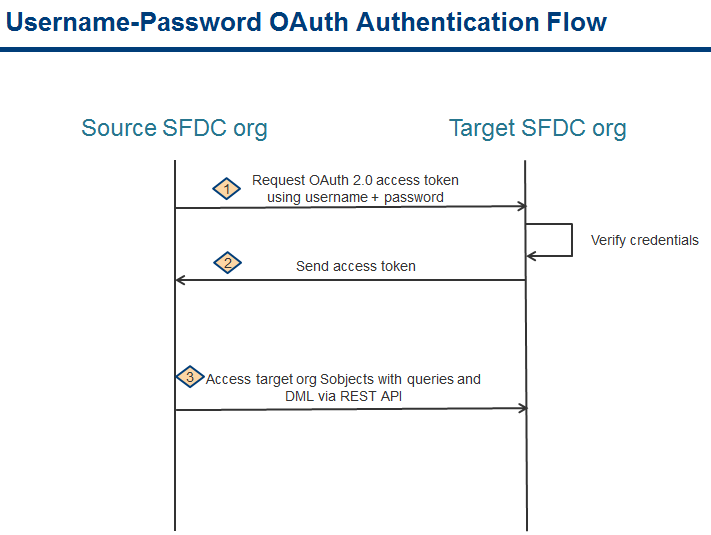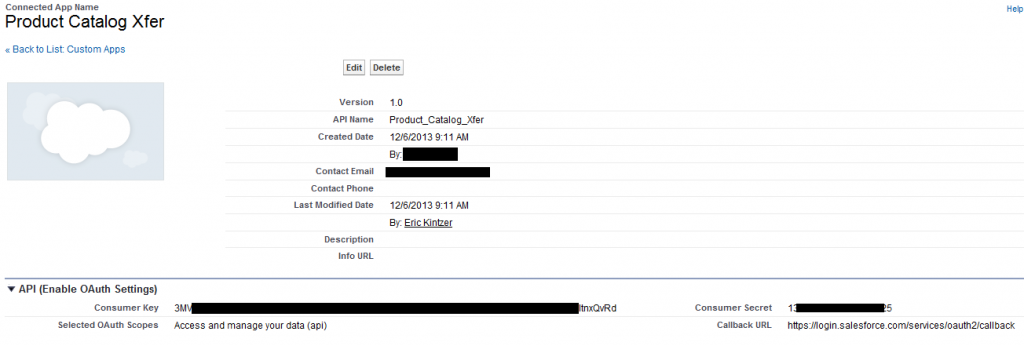Here was the business problem:
Migrate Product2-PricebookEntry-Pricebook2 data from a sandbox to staging sandbox and then onto production.
My previous brute force solution was to use the Excel Connector, querying rows from the Pricebook2, PricebookEntry, and Product2 tables using a connection to the sandbox, then successively inserting rows into the target org while replacing ID fields in the upload PricebookEntry dataset to match the just uploaded Pricebook2 and Product2 datasets. (PricebookEntry is a junction record between Pricebook2 and Product2). This involved Excel VLOOKUP functions and lots of care to make sure that I didn’t reorder rows by accident. Doing this once wasn’t so bad but the business changes the product line regularly and I was finding this tedious.
Solution Outline
Why not build an admin VF page in my org that could read from my source dataset sandbox and insert rows into the target sandbox/prod org? To make this happen, the Visualforce controller code would need to be able to do SOQL and DML against a different org. The way to do this is by exploiting the SFDC REST API and Apex HTTP Callouts.
The SFDC REST API documentation is written assuming that the calling application is not a Salesforce org but there is no restriction that this be so.
Step 1 – Authentication
The relevant SFDC REST API authentication documentation is here. I chose the username-password method as I’m the admin and would use this to get authentication on the target orgs using my own username and passwords on those orgs. I also opted for OAuth 2.0 authentication as I wanted to try this rather than using sessionIds.
public with sharing class HttpRest {
// Class to handle HTTP Rest calls to other SFDC instances
//
// [HTTP-00] - Reached limit on callouts
// [HTTP-01] - Unable to get OAuth 2.0 token from remote SFDC
// [HTTP-02] - Error in SOQL REST query
String accessToken; // OAuth 2.0 access token
String sfdcInstanceUrl; // Endpoint URL for SFDC instance
private HttpResponse send(String uri,String httpMethod) {
return send(uri,httpMethod,null);
}
private HttpResponse send(String uri, String httpMethod, String body) {
if (Limits.getCallouts() == Limits.getLimitCallouts())
throw new MyException('[HTTP-00] Callout limit: ' + Limits.getCallouts() + ' reached. No more callouts permitted.');
Http h = new Http();
HttpRequest hRqst = new HttpRequest();
hRqst.setEndpoint(uri); // caller provides, this will be a REST resource
hRqst.setMethod(httpMethod); // caller provides
hRqst.setTimeout(6000);
if (body != null)
hRqst.setBody(body); // caller provides
if (this.accessToken != null) // REST requires using the token, once obtained for each request
hRqst.setHeader('Authorization','Bearer ' + this.accessToken);
return h.send(hRqst); // make the callout
}
// ----------------------------------------------------------------------
// authenticateByUserNamePassword : Returns a map of <String,String> of the OAuth 2.0 access token; required before REST calls on SFDC instances can be made
// ----------------------------------------------------------------------
public void authenticateByUserNamePassword(String consumerKey, String consumerSecret, String uName, String uPassword, Boolean isSandbox) {
// Reference documentation can be found in the REST API Guide, section: 'Understanding the Username-Password OAuth Authentication Flow'
// OAuth 2.0 token is obtained from endpoints:
// PROD orgs : https://login.salesforce.com/services/oauth2/token
// SANDBOX orgs: https://test.salesforce.com/services/oauth2/token
// OAuth 2.0 access token contains these name/values:
// access_token : used in subsequent REST calls
// instance_url : to form the REST URI
// id : identifies end user
// issued_at : When signature was created
// signature : HMAC-SHA256 signature signed with private key - can be used to verify the instance_url
String uri = 'https://' + (isSandbox ? 'test' : 'login') + '.salesforce.com/services/oauth2/token';
String clientId = EncodingUtil.urlEncode(consumerKey,'UTF-8');
String clientSecret = EncodingUtil.urlEncode(consumerSecret,'UTF-8');
String username = EncodingUtil.urlEncode(uName,'UTF-8');
String password = EncodingUtil.urlEncode(uPassword,'UTF-8');
String body = 'grant_type=password&client_id=' + clientId +
'&client_secret=' + clientSecret +
'&username=' + username +
'&password=' + password;
HttpResponse hRes = this.send(uri,'POST',body);
if (hRes.getStatusCode() != 200)
throw new MyException('[HTTP-01] OAuth 2.0 access token request error. Verify username, password, consumer key, consumer secret, isSandbox? StatusCode=' +
hRes.getStatusCode() + ' statusMsg=' + hRes.getStatus());
System.debug(FlowControl.getLogLevel(),'response body =\n' + hRes.getBody());
Map<String,String> res = (Map<String,String>) JSON.deserialize(hRes.getBody(),Map<String,String>.class);
this.accessToken = res.get('access_token'); // remember these for subsequent calls
this.sfdcInstanceUrl = res.get('instance_url');
}
// -----------------------------------------------------------------------
// doSoqlQuery: Executes a REST query on a remote SFDC and returns a list of SObjects
// -----------------------------------------------------------------------
public List<SObject> doSoqlQuery(String query) {
List<Sobject> res;
PageReference urlPg = new PageReference(this.sfdcInstanceUrl + '/services/data/v29.0/query');
urlPg.getParameters().put('q',query);
String uri = urlPg.getUrl(); // let APEX do the URL encoding of the parms as necessary
HttpResponse hRes = this.send(uri,'GET');
if (hRes.getStatusCode() != 200)
throw new MyException('[HTTP-02] Error in query ' + uri + ' StatusCode=' +
hRes.getStatusCode() + ' statusMsg=' + hRes.getStatus());
// Response body comes back as:
// {"totalSize":10,
// "done":true,
// "records":[
// {"attributes":{
// "type" : "the sobject",
// "url" : "/services/data/v29.0/sobjects/the sobject/the id"
// },
// "field0 in query" : "value of field 0",
// "field1 in query" : "value of field1",
// ...},
// next record ...
// ]
// }
JSONParser jp = JSON.createParser(hRes.getBody());
do{
jp.nextToken();
} while(jp.hasCurrentToken() && !'records'.equals(jp.getCurrentName()));
jp.nextToken(); // token is 'records'
res = (List<SObject>) jp.readValueAs(List<SObject>.class); // Let caller cast to specific SObject
return res;
}
// --------------------------------------------------------------
// TEST METHODS - MOCKS
// ---------------------------------------------------------------
public class authenticateByUserNamePasswordMock implements HttpCalloutMock {
Boolean isMockResponseSuccessful;
public authenticateByUserNamePasswordMock(Boolean isMockResponseSuccessful) {
this.isMockResponseSuccessful = isMockResponseSuccessful;
}
public HttpResponse respond(HttpRequest rqst) {
HttpResponse hResp = new HttpResponse();
if (this.isMockResponseSuccessful) {
hResp.setStatusCode(200);
hResp.setBody('{' + // data copied from SFDC example
' "id":"https://login.salesforce.com/id/00Dx0000000BV7z/005x00000012Q9P", ' +
' "issued_at":"1278448832702",' +
' "instance_url": "https://na1.salesforce.com",' +
' "signature":"0CmxinZir53Yex7nE0TD+zMpvIWYGb/bdJh6XfOH6EQ=",' +
' "access_token": "00Dx0000000BV7z!AR8AQAxo9UfVkh8AlV0Gomt9Czx9LjHnSSpwBMmbRcgKFmxOtvxjTrKW19ye6PE3Ds1eQz3z8jr3W7_VbWmEu4Q8TVGSTHxs"'
+'}');
}
else {
hResp.setStatusCode(400);
hResp.setStatus('Bad request');
}
return hResp;
}
}
public class doSoqlQueryMock implements HttpCalloutMock {
Boolean isMockResponseSuccessful;
public doSoqlQueryMock(Boolean isMockResponseSuccessful) {
this.isMockResponseSuccessful = isMockResponseSuccessful;
}
public HttpResponse respond(HttpRequest rqst) {
HttpResponse hResp = new HttpResponse();
if (this.isMockResponseSuccessful) {
hResp.setStatusCode(200);
hResp.setBody('{' + // data copied from SFDC example
' "totalSize": 2,' +
' "done" : true,' +
' "records" : [' +
' { "attributes" : {' +
' "type" : "Account",' +
' "url" : "/services/data/v29.0/sobjects/Account/00id"' +
' },' +
' "ID" : "00id"' +
' },' +
' { "attributes" : {' +
' "type" : "Account",' +
' "url" : "/services/data/v29.0/sobjects/Account/01id"' +
' },' +
' "ID" : "01id"' +
' }' +
' ]' +
'}');
}
else {
hResp.setStatusCode(404);
hResp.setStatus('Not found');
}
return hResp;
}
}
// --------------------------------------------------------------
// TEST METHODS - tests
// ---------------------------------------------------------------
@isTest
private static void testAuthenticateByUserNamePassword() {
HttpRest hr = new HttpRest();
try {
Test.setMock(HttpCalloutMock.class, new authenticateByUserNamePasswordMock(true));
hr.authenticateByUserNamePassword('somekey','somesecret','someusername@somedomain','somepw+token',false);
System.assertEquals('00Dx0000000BV7z!AR8AQAxo9UfVkh8AlV0Gomt9Czx9LjHnSSpwBMmbRcgKFmxOtvxjTrKW19ye6PE3Ds1eQz3z8jr3W7_VbWmEu4Q8TVGSTHxs',hr.accessToken);
System.assertEquals('https://na1.salesforce.com',hr.sfdcInstanceUrl);
}
catch (Exception e) {System.assert(false,'shouldnt. Exception:' + e.getMessage() + e.getStackTraceString());}
try {
Test.setMock(HttpCalloutMock.class, new authenticateByUserNamePasswordMock(false));
hr.authenticateByUserNamePassword('somekey','somesecret','someusername@somedomain','somepw+token',false);
System.assert(false,'shouldnt happen, mock should produce error');
}
catch (Exception e) {System.assert(e.getMessage().contains('[HTTP-01]'),e.getMessage());}
}
@isTest
private static void testDoSoqlQuery() {
HttpRest hr = new HttpRest();
List<Sobject> sobjResList;
try {
Test.setMock(HttpCalloutMock.class, new doSoqlQueryMock(true));
sObjResList = hr.doSoqlQuery('select id from Account');
System.assertEquals(2,sObjResList.size());
}
catch (Exception e) {System.assert(false,'shouldnt. Exception:' + e.getMessage() + e.getStackTraceString());}
try {
Test.setMock(HttpCalloutMock.class, new doSoqlQueryMock(false));
sObjResList = hr.doSoqlQuery('select id from Account');
System.assert(false,'shouldnt happen, mock should produce error');
}
catch (Exception e) {System.assert(e.getMessage().contains('[HTTP-02]'),e.getMessage());}
}
}
Implementation Notes
- You’ll need your own Exception class for this to compile. The example calls it
MyException but I usually name these after the project or business unit wherein my code is deployed.
- Note that method
authenticateByUserNamePassword takes five arguments. You will need to set up the consumerKey and consumerSecret on the target org using Setup | Develop | Remote Access. Starting in V29.0, this is now called a ‘Connected App’. Your source org will need access to these values – perhaps through custom settings, directly-entered into your VF page, or for more security, as encrypted fields in an custom SObject.
- Your source org will need to Setup | Security Controls | Remote Site Settings for both the OAuth 2.0 authentication access token provider(s) as well as the target instance(s).
Connected App Setup in the target org
There are several OAuth scopes available to you. I chose ‘Access and manage your data (api)’ as that met my requirements.
Remote Site settings in the source org
In my source org, I set up four Remote Sites – two for the production and sandbox OAuth 2.0 access token providers and one each for the target PROD and target sandbox.




